On March 12-13, 2016, the Friends of the Cumbres & Toltec sponsored a snow-flanging special working west out of Antonito, CO. Having seen some of the incredible pictures of narrow gauge in the snow from the 2015 trip, I signed on immediately. Of course these sorts of things are very much a gamble – you never know if enough people will sign up to make it go, and you don’t know if Mother Nature will cooperate and bless you with a nice snowstorm the week before.
Still, you pay your money and take your chances, because the opportunity to see these machines in action is rare enough. If the weather cooperates, that’s just a bonus.
What’s a Flanger?
A flanger is a specialized type of snowplow that was pioneered by the Rio Grande. consists of a short, stout frame with a wedge snowplow mounted towards the front. Behind the plow are two blades that can be lowered to clean packed snow and ice out of where the wheel flanges ride on the inside of the rails. By cleaning out this area after plowing, it prevented railroad wheel flanges from riding up on the frozen accumulation and eventually popping over the railhead, causing a derailment.
The Rio Grande constructed the first one in Denver’s Burnham Shops in 1885 based (reportedly) on a patent from a Mr. Omerot, the foreman of the motive power shop in Leadville. (From a Gunnison Review Press article on Dec 12, 1885.) They put it to use, testing it on Marshall Pass in December 1885, and found it so successful that ten narrow gauge flangers were constructed, originally numbered 01-010 and eventually renumbered OC-OL. Eventually an eleventh machine was acquired from the defunct Crystal River Railroad, which became flanger OT. While the rotaries got much of the glory and attention, these flangers were the Rio Grande’s primary snow-fighting weapons on the narrow gauge from 1885 until the present day.
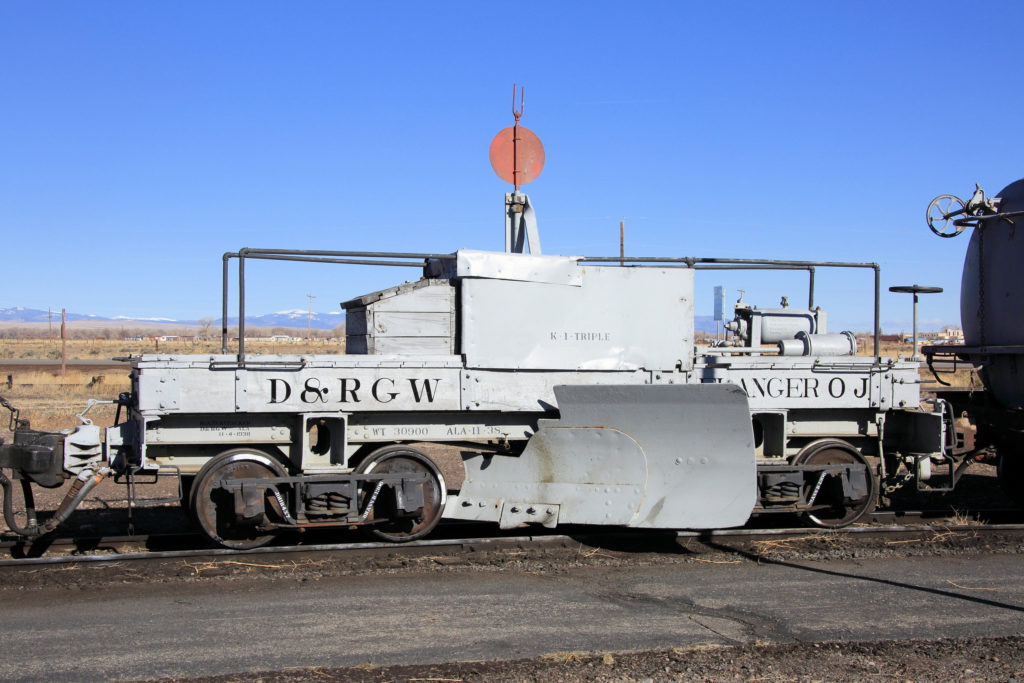
Day 1- Saturday, March 12, 2016
The previous year, the Friends had run a very successful snow plowing trip, with plenty of the white stuff on the ground. In 2016, though, luck wasn’t with us. What little snow accumulation there was was up beyond Sublette, and primarily lurking in dark tree tunnels and cuts. At 5am on Saturday, March 12, we were all in the yard freezing our asses off in zero degree darkness.
The reason for leaving so early was to get everybody oriented and ready for a sunrise shot out at Hangman’s Trestle. I have to admit, the shot turned out as the best of the trip, and one of my lifetime favorites. So it was most certainly worth it. Plus, just riding in the cupola of DRGW 0503 across the dark desert, watching the headlight play over the sagebrush and the exhaust suddenly erupt in an orange glow whenever the fireman opened the doors to shovel in coal was most definitely worth it as well. Nighttime on the narrow gauge is something far too few fans experience.
After the sunrise shots, we had a few more around Lava before working up towards Big Horn and finding our first little bits of snow. We’d brought up a flat car with a backhoe (I don’t remember why) as well as a tank filled with water since we wouldn’t have access to any out on the line. At Big Horn, we’d drop the flat and the tank, and continue as far as we could towards Sublette, stopping where we’d find snow.
Turns out, there wasn’t much to be found. A little bit here and there, generally just barely over the rail head. There were a couple spots where we’d get a drift deep enough that we could frame it to look like heavy snow, but the truth was most of what we were plowing was weeds.
With the crew having gone on duty around 4am (as I remember, anyway), we headed back fairly early to make sure we’d get home before they went dead on hours. I don’t think we made it any further west than about milepost 301. We went back to Big Horn, turned the train and picked up the cars we’d dropped, watered up, and headed back in to Antonito. We did stop for one more run-by at the lower end of Whiplash.
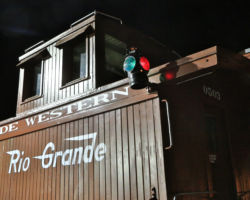
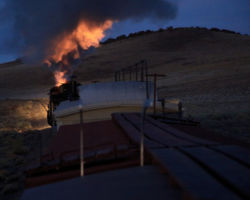
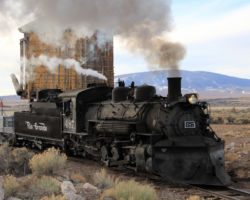
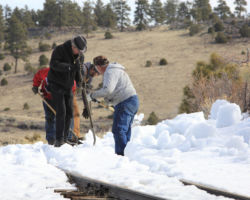
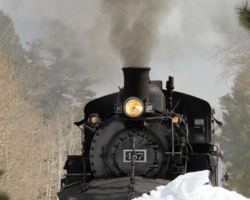
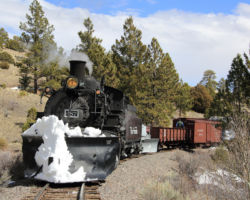
Day 2 – Sunday, March 13, 2016
Sunday we started at a much more civilized hour, departing Antonito around 9am. We did a few run-bys at the famous “End of Standard Gauge” sign, and then a couple more out in the desert to take advantage of a beautifully clear morning with the Sangre de Christos in the background.
From there, it was straight to where we left off. We found some small drifts in the cuts between 301 and 304, and then significant snow on the west side of the hill at 304. The only problem is that most of it was down narrow tree tunnels, which made accommodating a bunch of photographers and yet leaving room for safe passage of the plow a bit challenging. We managed anyway. We easily made it to Sublette, our intended westernmost end for the trip, but after watering up the crew decided to push just a little further west into some more deep shadowed snow before calling it a day.
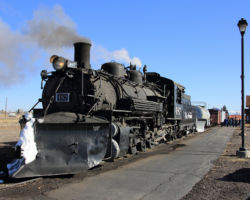
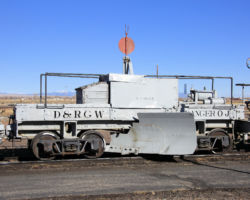
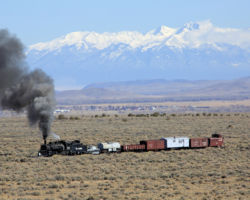
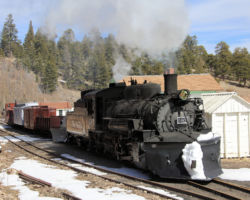
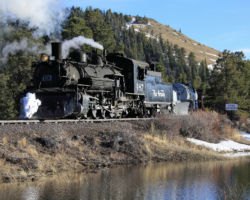
Acknowledgements
Thanks to the Friends of the C&TS for organizing this and many other trips over the years, as well as spending the countless volunteer hours and dollars to keep non-revenue equipment like OJ and the rest of our special train in top notch shape.
Thanks to Jerry Day and all he’s researched and written over the years on the Grande’s snow-fighting and how it was accomplished. For those interested in learning more about snow-fighting on the D&RGW, I recommend the the Q2 2019 and Q2 2012 issues of The Prospector, the Rio Grande Modeling & Historical Society’s quarterly magazine. Back issues are available for purchase.
And most of all, thanks to the C&TS for their willingness to run trips like this. Those of us who live in narrow gauge country are extremely lucky (and a bit spoiled) that we have such an amazing railroad.
This work is copyright 2024 by Nathan D. Holmes, but all text and images are licensed and reusable under a Creative Commons Attribution-NonCommercial-ShareAlike license. Basically you’re welcome to use any of this as long as it’s not for commercial purposes, you credit me as the source, and you share any derivative works under the same license. I’d encourage others to consider similar licenses for their works.


























